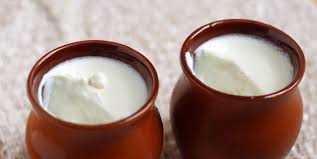 With the onset of summer, and the raised temperature, it is but normal that many of us bring about small changes in diet and routine. The warm clothes are replaced by light coloured cotton clothings, some start intake of cold drinks or cold water over warm sips of water, tea, coffee and/or soups, fresh fruits, juices and etc,etc… One more inclusion or advise which is very common, ‘Have a bowl of curd or curd rice- to keep cool’. How true and appropriate is this?
With the onset of summer, and the raised temperature, it is but normal that many of us bring about small changes in diet and routine. The warm clothes are replaced by light coloured cotton clothings, some start intake of cold drinks or cold water over warm sips of water, tea, coffee and/or soups, fresh fruits, juices and etc,etc… One more inclusion or advise which is very common, ‘Have a bowl of curd or curd rice- to keep cool’. How true and appropriate is this?
Now lets see what Ayurveda says about curd –
“।। अम्लपाकरसं ग्राहि गुरुष्णं दधि वातजित्।। मेदःशुक्रबलश्र्लेष्मपित्तरक्ताग्निशोफक्रृत् ।
रोचिष्णु शस्तमरुचौ शीतके विषमज्वरे।। पीनसे मूत्रकृच्छ्रे च रूक्षं तु ग्रहणीगदे।
नैवाद्यान्निशि नैवोष्णं वसन्तोष्णशरत्सु न।। नामुद्गसूपं नाक्षौद्रं तन्नाघृतसितोपलम्।
न चानामलकं नापि नित्यं नो मन्दमन्यथा।। ज्वरासृक् पित्त वीसर्पकुष्ठपाण्डुभ्रमप्रदम्। “वा.सू.५
Curd is sour in taste and vipaak (rasa dominant after digestion), heavy to digest, contrary to everyone’s belief it is hot in potency, pacifies vata, but increases kapha and pitta dosha.
Intake of curd builds up excess of meda dhatu (fats), increases rakta dhatu, shukra dhatu (sperm count), strength, kindles digestive fire and develops or stimulates swelling if any. Curd is also beneficial in conditions like anorexia, as it stimulates taste buds. In conditions like running nose or difficulty in micturition curd should be taken wisely with medicines to get desired relief.
Inspite of some of these beneficiary factors, Ayurveda advises some must follow RULES to have curd –
- Curd should never be taken at Night.
- Never Heat curd, or have it along with hot foods.
- Curd should be avoided strictly in Vasant (March to may), Sharad (October), Grishma (May till the start of rains) rutu, in short, when the climate is hot.
- Even though rutu, prakriti and conditions favour intake of Curd (Dadhi/dahi), Curd should not be taken Daily.
- Never have curd which is not well set.
- Curd Should not be taken alone. It should always be taken along with either honey/ghee/sugar/amla churna/rock salt or moong soup (mudga yush).
- If the above mentioned rules are neglected, on a frequent basis, it leads to complaints like fever, raktadushti, skin diseases, giddiness due to increased pitta, visarpa, increased heat in rakta dhatu causing bleeding through rectum /skin/nose, blood stained vomitting, etc.
- In today’s lifestyle, try and use homemade curd only. It is a very easy recipe.
Though Curd is a milk product, the process of curd formation not only changes its consistency and appearance, but also its taste, properties and effects on the body. The effect varies with individual depending upon prakriti, rutu, kaal (time),etc.
The ideal process to set curd –
- Always use clay or glass utensils, to set the curd
- Use whole milk.
- Boil milk properly, and allow it to cool
- The milk should be lukewarm, not too cold or hot, as this can disturb the consistency of the curd.
- Add 1 tsp of curd culture to warm milk, and mix well. Leave it to set overnight or minimum of 6-7 hrs.
- Curd sets faster in hot climate, whereas it takes longer time in winters.
- Always use well set curd.
So have curd wisely, follow all these rules, stay happy stay healthy.